
Concept explainers
(a)
Interpretation:
The structure of the molecule is to be drawn and the IUPAC name is to be provided that corresponds to the given trivial name.
Concept introduction:
Carboxylic acids are the compounds containing

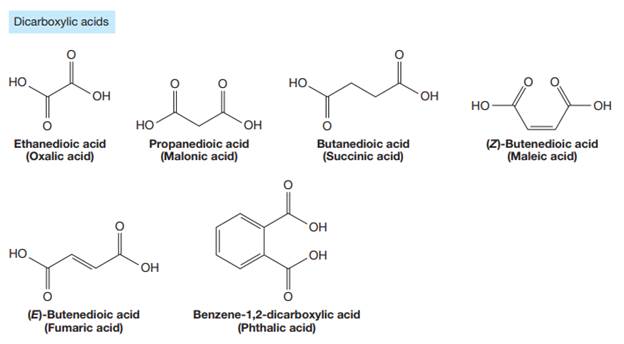
The carbonyl carbon atom is always numbered as C1 and the numbering continues. The substituents, if any, attached to the carbon chain are names according to the alphabetical order and the lowest locator number.
The trivial names of carboxylic acids are in the general form alkionic acid, while the IUPAC names are in the general form alkanoic acid. The suffix ‘ionic’ is replaced by ‘noic’ in the IUPAC name.
Answer to Problem F.12P
The structure of the molecule that corresponds to the given trivial name
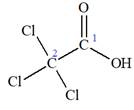
The IUPAC name of
Explanation of Solution
The given IUPAC name is

The portion ‘
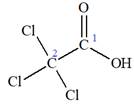
The IUPAC name of
The structure of the compound is drawn and the IUPAC name of the compound is written that corresponds to the given trivial name.
(b)
Interpretation:
The structure of the molecule is to be drawn and the IUPAC name is to be provided that corresponds to the given trivial name.
Concept introduction:
Carboxylic acids are the compounds containing

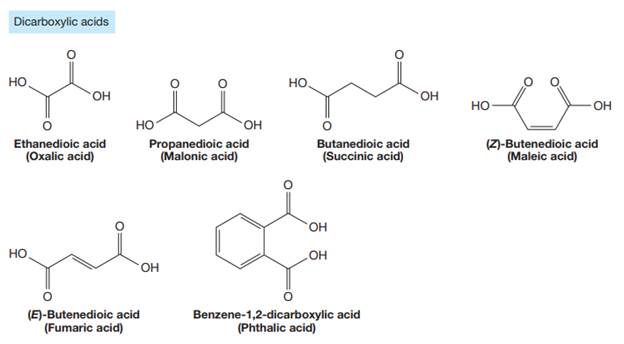
The carbonyl carbon atom is always numbered as C1 and the numbering continues. The substituents, if any, attached to the carbon chain are names according to the alphabetical order and the lowest locator number.
The trivial names of carboxylic acids are in the general form alkionic acid, while the IUPAC names are in the general form alkanoic acid. The suffix ‘ionic’ is replaced by ‘noic’ in the IUPAC name.
Answer to Problem F.12P
The structure of the molecule that corresponds to the given trivial name
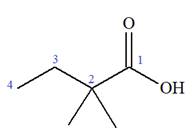
The IUPAC name of
Explanation of Solution
The given IUPAC name is
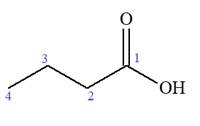
The prefix ‘2, 2-dimethyl’ indicates that the methyl group is attached at C2, and C2 carbon atoms of the butyric acid. The structure of
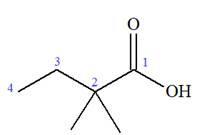
The trivial names of carboxylic acids are in the general form alkionic acid while the IUPAC names are in the general form alkanoic acid. The suffix ‘ionic’ is replaced by ‘noic’ in the IUPAC name.
The butyric acid is the trivial name, its IUPAC name is butanoic acid. Thus, the IUPAC name of
The structure of the compound is drawn and the IUPAC name of the compound is written that corresponds to the given trivial name.
(c)
Interpretation:
The structure of the molecule is to be drawn and the IUPAC name is to be provided that corresponds to the given trivial name.
Concept introduction:
Carboxylic acids are the compounds containing

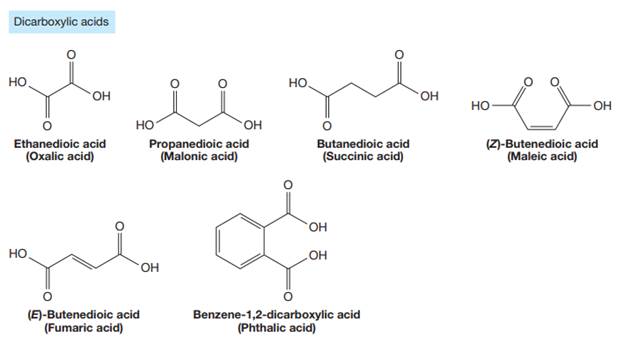
The carbonyl carbon atom is always numbered as C1 and the numbering continues. The substituents, if any, attached to the carbon chain are names according to the alphabetical order and the lowest locator number.
The trivial names of carboxylic acids are in the general form alkionic acid, while the IUPAC names are in the general form alkanoic acid. The suffix ‘ionic’ is replaced by ‘noic’ in the IUPAC name.
Answer to Problem F.12P
The structure of the molecule that corresponds to the given trivial name
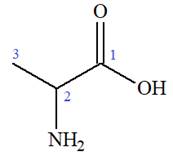
The IUPAC name of
Explanation of Solution
The given IUPAC name is
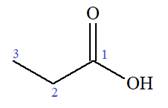
The prefix ‘2-amino’ indicates that

The trivial names of carboxylic acids are in the general form alkionic acid while the IUPAC names are in the general form alkanoic acid. The suffix ‘ionic’ is replaced by ‘noic’ in the IUPAC name.
The propionic acid is the trivial name; its IUPAC name is propanoic acid. Thus, the IUPAC name of
The structure of the compound is drawn and the IUPAC name of the compound is written that corresponds to the given trivial name.
(d)
Interpretation:
The structure of the molecule is to be drawn and the IUPAC name is to be provided that corresponds to the given trivial name.
Concept introduction:
Carboxylic acids are the compounds containing


The carbonyl carbon atom is always numbered as C1 and the numbering continues. The substituents, if any, attached to the carbon chain are names according to the alphabetical order and the lowest locator number.
The trivial names of carboxylic acids are in the general form alkionic acid, while the IUPAC names are in the general form alkanoic acid. The suffix ‘ionic’ is replaced by ‘noic’ in the IUPAC name.
Answer to Problem F.12P
The structure of the molecule that corresponds to the given trivial name
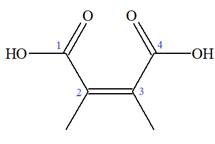
The IUPAC name of
Explanation of Solution
The given IUPAC name is

Note the stereochemistry about the doubly bonded carbon atoms. The two high-priority groups are on the same side of the double bond making it (Z) stereoisomer.
The prefix
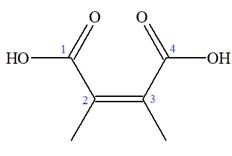
As the longest carbon chain has four atoms, the root name for carboxylic acid is
The structure of the compound is drawn and the IUPAC name of the compound is written that corresponds to the given trivial name.
(e)
Interpretation:
The structure of the molecule is to be drawn and the IUPAC name is to be provided that corresponds to the given trivial name.
Concept introduction:
Carboxylic acids are the compounds containing


The carbonyl carbon atom is always numbered as C1 and the numbering continues. The substituents, if any, attached to the carbon chain are names according to the alphabetical order and the lowest locator number.
The trivial names of carboxylic acids are in the general form alkionic acid, while the IUPAC names are in the general form alkanoic acid. The suffix ‘ionic’ is replaced by ‘noic’ in the IUPAC name.
Answer to Problem F.12P
The structure of the molecule that corresponds to the given trivial name

The IUPAC name of
Explanation of Solution
The given IUPAC name is

The prefix ‘diethyl’ in the name suggests that an ethyl group is attached at C2 carbon atom of the root. The locator numbers 2 and 2 are not included in the name because there is only one carbon atom to which any substituent could get attached. Thus, the complete structure of

As the longest carbon chain has three atoms, the root name for this dicarboxylic acid is
The structure of the compound is drawn and the IUPAC name of the compound is written that corresponds to the given trivial name.
Want to see more full solutions like this?
Chapter F Solutions
Organic Chemistry: Principles and Mechanisms (Second Edition)
- Draw the molecules.arrow_forwardDraw the mechanism for the acid-catalyzed dehydration of 2-methyl-hexan-2-ol with arrows please.arrow_forward. Draw the products for addition reactions (label as major or minor) of the reaction between 2-methyl-2-butene and with following reactants : Steps to follow : A. These are addition reactions you need to break a double bond and make two products if possible. B. As of Markovnikov rule the hydrogen should go to that double bond carbon which has more hydrogen to make stable products or major product. Here is the link for additional help : https://study.com/academy/answer/predict-the-major-and-minor-products-of-2-methyl- 2-butene-with-hbr-as-an-electrophilic-addition-reaction-include-the-intermediate- reactions.html H₂C CH3 H H3C CH3 2-methyl-2-butene CH3 Same structure CH3 IENCESarrow_forward
- Draw everything on a piece of paper including every single step and each name provided using carbons less than 3 please.arrow_forwardTopics] [References] Write an acceptable IUPAC name for the compound below. (Only systematic names, not common names are accepted by this question.) Keep the information page open for feedback reference. H The IUPAC name isarrow_forward[Review Topics] [References] Write an acceptable IUPAC name for the compound below. (Only systematic names, not common names are accepted by this question.) Keep the information page open for feedback reference. The IUPAC name is Submit Answer Retry Entire Group 9 more group attempts remainingarrow_forward
- Please draw.arrow_forwardA chromatogram with ideal Gaussian bands has tR = 9.0 minutes and w1/2 = 2.0 minutes. Find the number of theoretical plates that are present, and calculate the height of each theoretical plate if the column is 10 centimeters long.arrow_forwardAn open tubular column has an inner diameter of 207 micrometers, and the thickness of the stationary phase on the inner wall is 0.50 micrometers. Unretained solute passes through in 63 seconds and a particular solute emerges at 433 seconds. Find the distribution constant for this solute and find the fraction of time spent in the stationary phase.arrow_forward
- Consider a chromatography column in which Vs= Vm/5. Find the retention factor if Kd= 3 and Kd= 30.arrow_forwardTo improve chromatographic separation, you must: Increase the number of theoretical plates on the column. Increase the height of theoretical plates on the column. Increase both the number and height of theoretical plates on the column. Increasing the flow rate of the mobile phase would Increase longitudinal diffusion Increase broadening due to mass transfer Increase broadening due to multiple paths You can improve the separation of components in gas chromatography by: Rasing the temperature of the injection port Rasing the temperature of the column isothermally Rasing the temperature of the column using temperature programming In GC, separation between two different solutes occurs because the solutes have different solubilities in the mobile phase the solutes volatilize at different rates in the injector the solutes spend different amounts of time in the stationary phasearrow_forwardplease draw and example of the following: Show the base pair connection(hydrogen bond) in DNA and RNAarrow_forward
 World of Chemistry, 3rd editionChemistryISBN:9781133109655Author:Steven S. Zumdahl, Susan L. Zumdahl, Donald J. DeCostePublisher:Brooks / Cole / Cengage Learning
World of Chemistry, 3rd editionChemistryISBN:9781133109655Author:Steven S. Zumdahl, Susan L. Zumdahl, Donald J. DeCostePublisher:Brooks / Cole / Cengage Learning Chemistry for Today: General, Organic, and Bioche...ChemistryISBN:9781305960060Author:Spencer L. Seager, Michael R. Slabaugh, Maren S. HansenPublisher:Cengage Learning
Chemistry for Today: General, Organic, and Bioche...ChemistryISBN:9781305960060Author:Spencer L. Seager, Michael R. Slabaugh, Maren S. HansenPublisher:Cengage Learning Organic Chemistry: A Guided InquiryChemistryISBN:9780618974122Author:Andrei StraumanisPublisher:Cengage Learning
Organic Chemistry: A Guided InquiryChemistryISBN:9780618974122Author:Andrei StraumanisPublisher:Cengage Learning Introductory Chemistry: An Active Learning Approa...ChemistryISBN:9781305079250Author:Mark S. Cracolice, Ed PetersPublisher:Cengage Learning
Introductory Chemistry: An Active Learning Approa...ChemistryISBN:9781305079250Author:Mark S. Cracolice, Ed PetersPublisher:Cengage Learning




